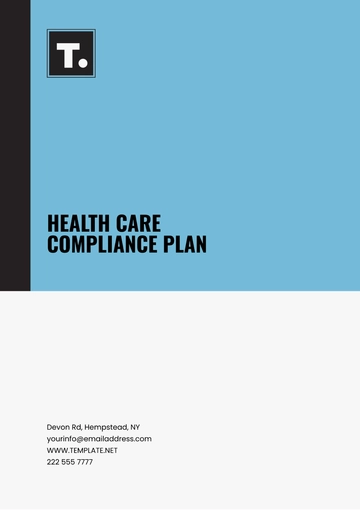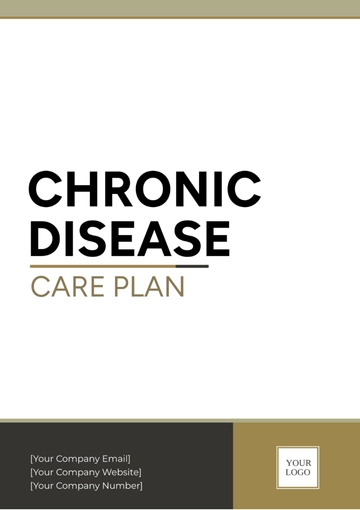Free Simple HIPAA Compliance Plan

Date: [Date]
Prepared By: [Your Name]
1. Introduction
The Health Insurance Portability and Accountability Act, commonly abbreviated as HIPAA, imposes strict requirements to ensure the protection of sensitive patient information. This comprehensive plan has been developed to guarantee adherence to the standards set forth by HIPAA, thereby ensuring that Protected Health Information, or PHI, is securely maintained and safeguarded within the organization.
2. Purpose
In order to establish thorough procedures aimed at ensuring compliance with the Health Insurance Portability and Accountability Act (HIPAA) regulations, it is essential to implement comprehensive measures that protect the confidentiality, integrity, and security of Protected Health Information (PHI). Additionally, these procedures should be designed to significantly decrease the potential risk of data breaches or incidents of unauthorized access to sensitive information.
3. Scope
This plan is applicable to every individual employed by the organization, including those serving in temporary or freelance capacities, as well as any partners affiliated with the organization, who have the ability to access protected health information, which may be stored or transmitted either in electronic formats or as physical documents.
4. Roles and Responsibilities
HIPAA Compliance Officer: Oversees the implementation and maintenance of the HIPAA compliance plan.
Employees: Adhere to HIPAA policies and report potential security issues.
IT Department: Ensures the security of electronic PHI and implements security measures such as encryption and firewalls.
5. Policies and Procedures
5.1 Privacy Policies
Ensure PHI is only accessible to authorized individuals.
Restrict sharing of PHI to the minimum necessary amount for business operations.
Train employees on the importance of patient confidentiality.
5.2 Security Measures
Implement technical safeguards such as encryption for electronic PHI.
Use access controls to limit access to PHI and ensure that only authorized personnel can access it.
Regularly update software to protect against security vulnerabilities.
5.3 Breach Notification Procedures
In the event of a breach, notify affected individuals within 60 days.
Report breaches to the Department of Health and Human Services (HHS) and local authorities, as required by law.
5.4 Employee Training
Provide regular HIPAA training for all employees, emphasizing the importance of protecting PHI.
Keep records of all training sessions for auditing purposes.
5.5 Documentation and Recordkeeping
Maintain records of policies, procedures, training, and audits for a minimum of six years.
Ensure documentation is easily accessible for review during audits.
6. Risk Assessment and Management
Conduct periodic risk assessments to identify potential vulnerabilities.
Implement corrective actions to address identified risks.
Regularly update the risk management plan.
7. Incident Reporting and Response
Establish a clear protocol for reporting suspected HIPAA violations or security breaches.
Investigate all incidents promptly and take corrective actions as necessary.
8. Review and Updates
Review the compliance plan annually and after any major organizational changes or regulatory updates.
Update policies and procedures as needed to ensure continued compliance with HIPAA.
9. Conclusion
By adhering to the above policies and procedures, our organization commits to maintaining HIPAA compliance, protecting patient information, and minimizing the risks associated with breaches of confidentiality.
- 100% Customizable, free editor
- Access 1 Million+ Templates, photo’s & graphics
- Download or share as a template
- Click and replace photos, graphics, text, backgrounds
- Resize, crop, AI write & more
- Access advanced editor
Streamline your healthcare compliance process with the Simple HIPAA Compliance Plan Template offered by Template.net. This customizable, downloadable, and printable template ensures adherence to HIPAA regulations with ease. Editable in our AI Editor Tool, it’s designed for effortless personalization to meet your organization’s needs. Stay compliant and organized with this professional solution today!
You may also like
- Finance Plan
- Construction Plan
- Sales Plan
- Development Plan
- Career Plan
- Budget Plan
- HR Plan
- Education Plan
- Transition Plan
- Work Plan
- Training Plan
- Communication Plan
- Operation Plan
- Health And Safety Plan
- Strategy Plan
- Professional Development Plan
- Advertising Plan
- Risk Management Plan
- Restaurant Plan
- School Plan
- Nursing Home Patient Care Plan
- Nursing Care Plan
- Plan Event
- Startup Plan
- Social Media Plan
- Staffing Plan
- Annual Plan
- Content Plan
- Payment Plan
- Implementation Plan
- Hotel Plan
- Workout Plan
- Accounting Plan
- Campaign Plan
- Essay Plan
- 30 60 90 Day Plan
- Research Plan
- Recruitment Plan
- 90 Day Plan
- Quarterly Plan
- Emergency Plan
- 5 Year Plan
- Gym Plan
- Personal Plan
- IT and Software Plan
- Treatment Plan
- Real Estate Plan
- Law Firm Plan
- Healthcare Plan
- Improvement Plan
- Media Plan
- 5 Year Business Plan
- Learning Plan
- Marketing Campaign Plan
- Travel Agency Plan
- Cleaning Services Plan
- Interior Design Plan
- Performance Plan
- PR Plan
- Birth Plan
- Life Plan
- SEO Plan
- Disaster Recovery Plan
- Continuity Plan
- Launch Plan
- Legal Plan
- Behavior Plan
- Performance Improvement Plan
- Salon Plan
- Security Plan
- Security Management Plan
- Employee Development Plan
- Quality Plan
- Service Improvement Plan
- Growth Plan
- Incident Response Plan
- Basketball Plan
- Emergency Action Plan
- Product Launch Plan
- Spa Plan
- Employee Training Plan
- Data Analysis Plan
- Employee Action Plan
- Territory Plan
- Audit Plan
- Classroom Plan
- Activity Plan
- Parenting Plan
- Care Plan
- Project Execution Plan
- Exercise Plan
- Internship Plan
- Software Development Plan
- Continuous Improvement Plan
- Leave Plan
- 90 Day Sales Plan
- Advertising Agency Plan
- Employee Transition Plan
- Smart Action Plan
- Workplace Safety Plan
- Behavior Change Plan
- Contingency Plan
- Continuity of Operations Plan
- Health Plan
- Quality Control Plan
- Self Plan
- Sports Development Plan
- Change Management Plan
- Ecommerce Plan
- Personal Financial Plan
- Process Improvement Plan
- 30-60-90 Day Sales Plan
- Crisis Management Plan
- Engagement Plan
- Execution Plan
- Pandemic Plan
- Quality Assurance Plan
- Service Continuity Plan
- Agile Project Plan
- Fundraising Plan
- Job Transition Plan
- Asset Maintenance Plan
- Maintenance Plan
- Software Test Plan
- Staff Training and Development Plan
- 3 Year Plan
- Brand Activation Plan
- Release Plan
- Resource Plan
- Risk Mitigation Plan
- Teacher Plan
- 30 60 90 Day Plan for New Manager
- Food Safety Plan
- Food Truck Plan
- Hiring Plan
- Quality Management Plan
- Wellness Plan
- Behavior Intervention Plan
- Bonus Plan
- Investment Plan
- Maternity Leave Plan
- Pandemic Response Plan
- Succession Planning
- Coaching Plan
- Configuration Management Plan
- Remote Work Plan
- Self Care Plan
- Teaching Plan
- 100-Day Plan
- HACCP Plan
- Student Plan
- Sustainability Plan
- 30 60 90 Day Plan for Interview
- Access Plan
- Site Specific Safety Plan

















